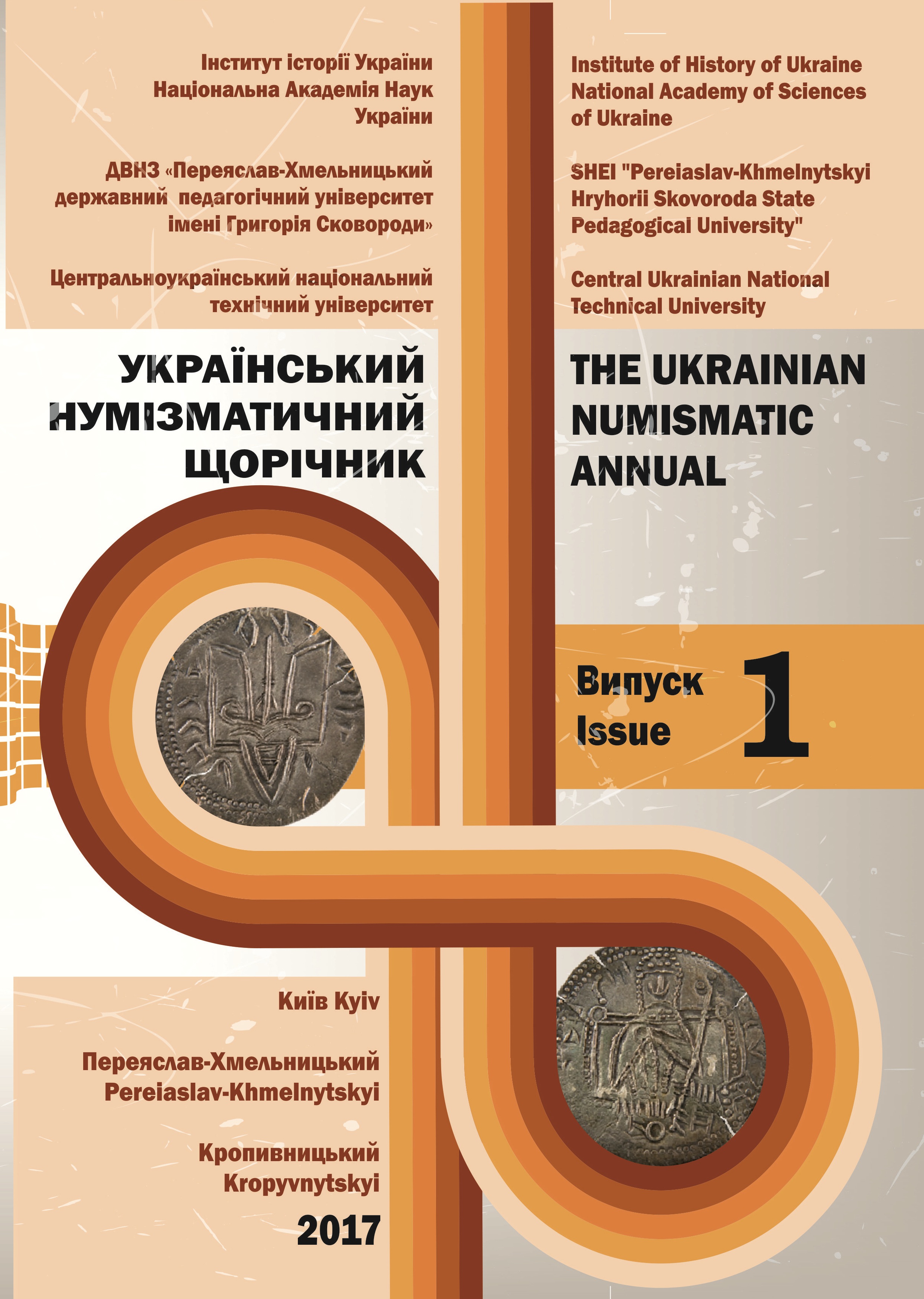Історіографія українського скарбознавства
HISTORIOGRAPHY OF THE UKRAINIAN TREASUROLOGY
Author(s): Victor KotsurSubject(s): History, Economic history
Published by: ДВНЗ Переяслав-Хмельницький державний педагогічний університет імені Григорія Сковороди
Keywords: hoard; treasury; thesaurus of coins; money circulation; Ukrainian lands; sources of study of numismatics; methods of numismatic research;
Summary/Abstract: The article deals with the historiography of the study of treasures of coins connected with the history of monetary circulation of Ukrainian historic regions. The totality of knowledge about the coin treasures, namely: the source value of the coin complexes, their classification, the causesof tezavrasii, topography of finds, the composition of treasures, treasure trove of the methodology and sources of research is determined by the notion of treasury.The definitions of the concept of treasure are quite complete and qualitatively presented in numismatic dictionaries. Given the fact that the numismatics science has been substantially The Ukrainian Numismatic Annual, Issue 1.16enriched with new knowledge, we consider it necessary to supplement the definition of the concept of treasure. In addition to the works of the predecessors of the signs, it should be added that treasures can consist not only of coins, but also of paper money, and other valuables, of scrap of precious metal, etc.Study and detailed analysis of treasures is one of the effective tools in clarifying certain issues of metrology of coins and their systems, which in previous studies we defined as one of the most important directions of modern studies on numismatics of the Middle Ages in the history of Ukrainian historic lands.Treasures are closely linked to Ukrainian folklore, endowed with enchantment, mystery, are often spoken or spellbound.In prerevolutionary historiography, leading domestic researchers paid attention to the issue of treasures' receipt for the collection of St. Volodymyr's University's Münster Cabinet, as illustrated by K. Strashkevich. Also, research focused mainly around the compilation of the topography of finds of coin treasures in some historical regions of Ukraine studied: the findings ofPolissya –M.F.Bilyashivsky, Volyn –V.B. Antonovich,Northern Black Sea Region –V.Goshkevich.Numerous references to the finds of treasures are contained in Ukrainian pre-revolutionary newspaper periodicals.In the prewar period, the attention of domestic numismatists in the focus of the treasury was focused mainly on expanding representations about the topography of treasures, the findings of the coins of Kievan Rus’were fixed by A.Ilyin, the question of the distribution of coins of ancient Rome and their finds –V. Lyaskoronsky.Attention to the topography of the finds of coin treasures in some historical regions of Ukraine was given to Soviet scientists: the common findings of coins of the 16th–17thcenturies are described by D. Berg, the findings of treasures on the territory of historical Podillya –M. Kotljar, historical Sivershchyna –V. Ryabtsevich, findings Western European early medieval coins published by V. Potin, Roman coins on the territory of the USSR –V. Kropotkin. The treasure of the Roman antoninists from the Crimean peninsula was published by I. Pioro and A. Herzenim, the coins of the Byzantine Kherson –A. Gilevich.Fundamentals of domestic treasury and the main aspects of the methodology of scientific study of treasures laid by MykolaKotlyar. One of the sensational cases was the discovery of a whole treasure of coins captured in Kyiv on behalf of DukeVolodymyr Olgerdovich, also investigated by M. F. Kotlyar.During the period of Ukraine's independence, scholarly fixation of treasures and the study of their role as sources in the study of the history of monetary circulation of Ukrainian historic regions were studied by O. Popelnytska and O. Bakalets.An important source in the study of treasury aspects is the data archives, as well as Internet resources.Among the complex finds of coins are known numismatists and certain special finds, or non-standard treasures. Examples of such finds are monist –jewelry made of coins, as well as cases of finds in coins of treasures that are uncharacteristic of the monetary structure of a particular period and region.Consequently, from the above material,the following conclusions and suggestions can be made. Treasures found on the territory of Ukrainian historic regions are a powerful source of study of the history of money circulation. Attention to the study of treasures was given to both Ukrainianand foreign researchers since the time of the Russian Empire, which emphasizes the high importance and relevance of their study. An impressive array of treasure information includes archival sources, modern digital information Internet resources, newspapers, and more. The study of treasures is reflected not only in popular science-historical intelligence, but also in scientific profile research: scientific reports, descriptions, topographies, complex studies and scientific dissertations. Mint treasures stored inmuseums' funds are actively introduced into scientific circulation. As for the method of treasury storage in museums, we see the actual development of a modern instruction on the storage and marking of coins in the study and research of treasures.Taking into account the fact that the numerous treasures showing already known "slices" of monetary circulation of certain historical regions in different historical periods have already beenpublished and are widely studied, further researches of modern scholarswe see in the study of Український нумізматичний щорічник.Вип.1.17treasures with a composition that is different based on the structure of the classical, contains previously unknown in the treasure coin, clarifies or emphasizes the role of coins of individual issuers in the monetary circulation ofUkraine and Eastern and Central Europe in total
Journal: Український Нумізматичний Щорічник
- Issue Year: 2017
- Issue No: 1
- Page Range: 15-32
- Page Count: 18
- Language: Ukrainian

